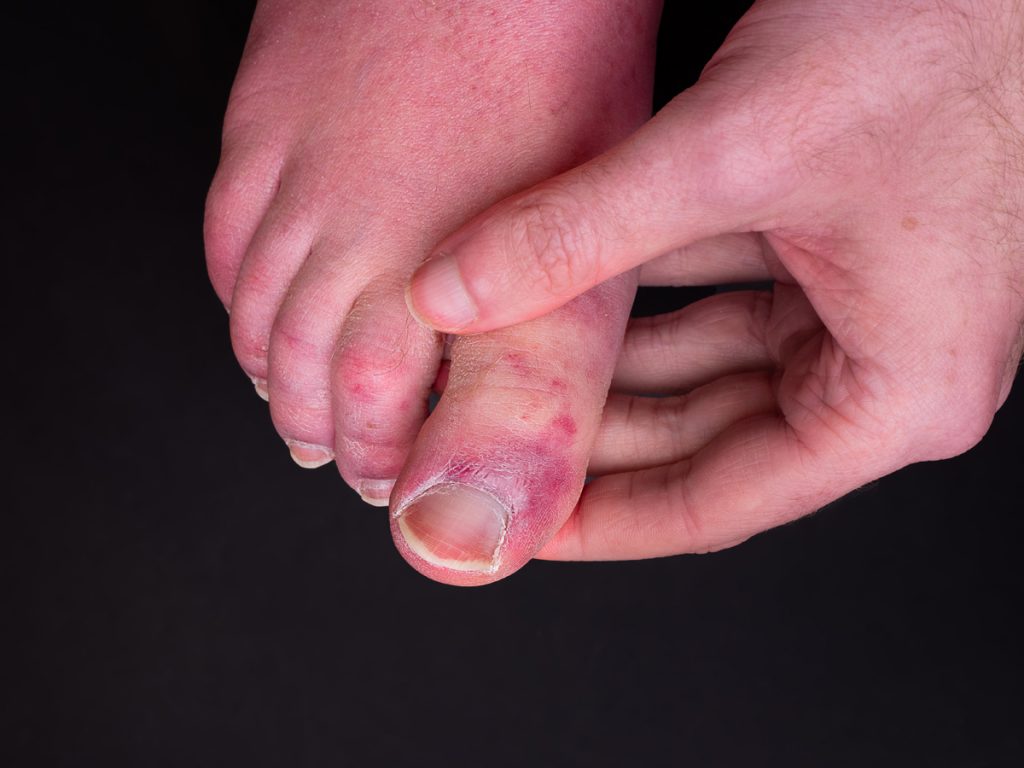Brrrrrrrrr!!! It’s a frosty time of year and an important time to keep your fingers and toes warm. This is also the time of year when we see chilblains appearing on the tips of the toes of many of our patients.
What are chilblains?
Chilblains are small lesions or bumps that can form on distal body parts such as the tips of toes, fingers, ears, and noses. These are localised forms of vasculitis that form following exposure to damp, cold, and non-freezing conditions. They can be tender, itchy, or have a burning pain, and in some cases, there are no symptoms. It is also common to see small red or darkened lesions where the chilblain has formed. Swelling, blistering and either blanching or a red/purple colouring of the digit may also be seen.
Chilblains may also be referred to as pernio.
Who gets chilblains?
Chilblains can affect people of all ages, but are more commonly seen in middle-age adults and in women. Chilblains tend to be seasonal, occurring during the colder, winter months. Other risk factors for developing chilblains includes:

- Smoking
- Low body mass index or poor nutrition
- Outdoor workers, such as fishermen and farmers
- Participation in snow or ice sports
- Poor circulation
- Raynaud’s phenomenon
- Underlying autoimmune disorders, bone marrow disorders, or connective tissue disorders
- Familial tendency to developing chilblains
Why do chilblains affect my feet?
Chilblains can occur after exposure to cold, damp environments when the small blood vessels in the fingers and toes constrict reducing blood flow. This response by the body is to preserve warm blood flow around the torso and vital organs. If this constriction to the digits is prolonged or repetitive, chilblains can form when the skin is rewarmed and blood flows back to the digits causing swelling and inflammation of the blood vessels.
Chilblains will usually develop within 24 hours of cold exposure, and should resolve within 1-3 weeks. Chilblains can also occur secondary to other medical conditions, such as vasculitis or chronic autoimmune conditions.
What can I do for myself and my feet?
The best way to prevent chilblains from occurring is to keep feet and hands warm and dry during the cold, winter months and avoiding long exposure to the cold. If chilblains develop, treatment includes protecting the affected areas from the cold, as well as topical creams and ointments to help them heal.
Protecting your feet from the cold includes making sure your footwear is well insulated and doesn’t allow your feet to get wet. Lightweight summer shoes and floppy, ill-fitting gumboots may not be able to offer this warmth and protection. Wearing warm socks with synthetic or natural fibers (wool or bamboo), can help insulate the feet and hold moisture away from the skin. Socks made from 100% cotton are not ideal as they can become damp from sweat or wet conditions, and will hold the moisture against the skin.
In cases where the toes can become cold, the use of lamb or alpaca wool can be used to weave and pad around the toes before the sock is put on. This can provide an extra layer of insulation, help remove any moisture between the toes, and can pad the tips of the toes for more comfort.
Movement and exercise are also beneficial to encourage blood flow through the lower limb and feet. The motion of apply moisturiser to the feet and toes can also encourage circulation to the digits. Specialised moisturisers are available from your local Resonance podiatry clinic to aid in warming the feet and digits as well as preventing and healing chilblains. Further topical creams and ointments can be available by prescription from your GP if needed.
It is best to avoid quick transitions from warm to cold temperatures, or vice versa. For example, warm your hands before going outside to the cold weather or gradually warm up your hands when moving inside from the cold. Putting cold feet under hot water or directly in front of a heater can elicit a physiological vascular response and make you more prone to developing or worsen chilblains.
What can a podiatrist do for me?
If you find your toes are becoming sore, have red lesions, or any other signs of chilblains, a podiatrist can assess your feet and make the right diagnosis. They can also check the circulation to your feet and any other signs that may put you at risk of developing chilblains. Conditions such as diabetes or poor circulation may affect the ability for chilblains to heal. A podiatrist can also assess your socks and footwear and make recommendations as needed.
Most chilblains will resolve on their own, but in some cases, they may blister or ulcerate. If the chilblain does blister or ulcerate, there is a risk of infection. The podiatrist can provide treatment and advice to reduce the risk of infection, monitor these lesions, and make referrals to specialists as needed.
Written by Resonance Podiatrist Megan McPherson
References:
Dermnet NZ. (2021, February). Chilblains. Retrieved from https://dermnetnz.org/topics/chilblains/
Mayo Clinic. (2020, December 1). Chilblains. Retrieved from https://www.mayoclinic.org/diseases-conditions/chilblains/symptoms-causes/syc-20351097
Sammassimo, A. (2018). Winter is coming: managing chilblains in community pharmacy. The Australian Journal of Pharmacy, 99(1172): 86-89. DOI: 10.3316/informit.557062699741868

